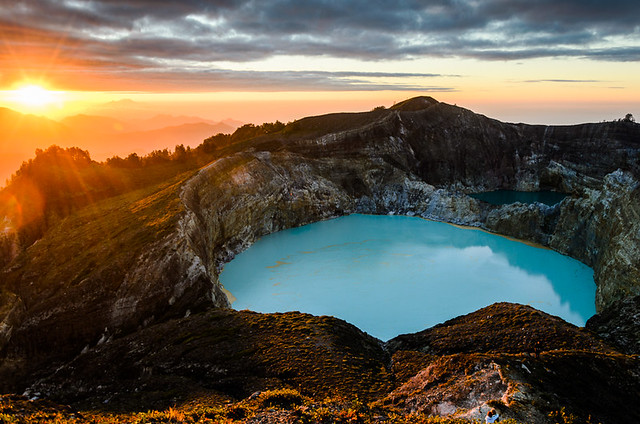The craters atop Kelimutu Volcano conceal a trio of gorgeous lakes that change colours throughout the year

In pictures, the tri-coloured lakes of Mt Kelimutu look like a dreamscape. Lined up in a row, each lake almost always takes on a different colour from the others – and many times, they’re a vibrant spectrum to behold.
The lakes of Kelimutu – meaning “boiling lake” – have been observed to appear blue, green, black, white, red and blue. Yes, and at different, totally unpredictable timings too. So don’t be disheartened to see one lake a murky chocolate brown – the one beside it may just be a shocking shade of red!

The westernmost lake is called Tiwu Ata Mbupu, meaning “the lake of old people”. The middle one is named Tiwu Nuwa Muri Koo Fai, or “the lake for young men and maidens”. Finally, the easternmost one is called Tiwu Ata Polo, or “the lake for evil spirits”.
Colours of the Wind

The constant and unpredictable changing palette of the lakes has remained an intriguing subject, even though it’s been scientifically explained.
Research states that lakes change colours due to minor eruptions over time via subaqueous fumaroles at the bottom of the lakes. These create highly-acidic water bodies, which Mt Kelimutu’s lakes are.
However, that doesn’t quite explain why all three lakes take on different colours simultaneously. Local rangers at Kelimutu National Park will tell you that it’s because of materials contained within each lake.
The locals of Moni, on the other hand, believe that it is a result of people who have committed evil deeds and died around the mountain. I think I’m going to go with this folklore!
A Surreal Park
The lakes are part of Kelimutu National Park, one of the most beautiful natural masterpieces of Indonesia. At 1690m, Mt. Kelimutu is the park’s second-highest point, behind Mt Kelibara’s 1731m.
The park protects 19 endemic and endangered animal species, including the native Floresian eagle (Spizaetus floris), the Wallacea owl (Otus silvicola), and the Timorese tesia (Tesia everetti).

The Kelimutu area is also home to flora that is rarely found in other parts of Flores. Locals believe that Mt. Kelimutu is a sacred source of fertility to the surrounding lands.
Challenging Climb
As with all good things, we must work hard to get to the treasure at the top of this mountain. Kelimutu’s lakes lie atop an endless, winding road that takes hours to traverse by car. The path features sharp turns, but which offers unparalleled panoramic views of Flores Island.
Several parts of Kelimutu National Park are restricted due to geothermal instability, so trekking is the best mode of travelling within the safe areas around Mt Kelimutu. Even after your car ride up to the parking area, it’s a 12km rocky trek to the peak that will take about half an hour.
But ask all who have braved this route, and they’ll tell you that it’s entirely worth it. And they would do it all over again, just to see the lakes magically shift into a new spectrum.
By Pamela Chow
ADVERTISEMENTS












Leave a Reply